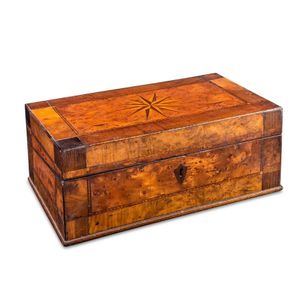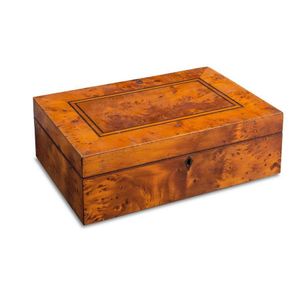Ebony Inlaid Huon Pine Sewing Box from Tasmania (11 words)
You must be a subscriber, and be logged in to view price and dealer details.
Subscribe Now to view actual auction price for this item
When you subscribe, you have the option of setting the currency in which to display prices to $Au, $US, $NZ or Stg.
- Ebony - Ebony is a close grained timber, black in colour. It has a fine texture which can be polished to a high gloss, making it suitable for venereering, inlay and stringing and its use as solid timber is resticted to small decorative items and ornamental decoration, such as chess pieces and musical instrument parts. The term "ebonised" means "faux ebony", timber that has been darkened during the polishing process to resemble ebony.
- Circa - A Latin term meaning 'about', often used in the antique trade to give an approximate date for the piece, usually considered to be five years on either side of the circa year. Thus, circa 1900 means the piece was made about 1900, probably between 1895 and 1905. The expression is sometimes abbreviated to c.1900.
- Casuarina - Casuarina, is also known as beefwood (because of its appearance) she-oak, swamp oak, river oak, forest oak and Botany Bay wood. It is a native Australian hardwood, red brown in colour with dark flecks.
- Huon Pine - Named after the Frenchman who discovered the Huon River in Tasmania, it is an extremely slow growing and long living tree. Huon pine is native to Tasmania, and it can grow to an age of 3,000 years or more. The wood contains oil that retards the growth of fungi, hence its early popularity in ship-building in convict-era Tasmania. The timber is a warm yellow colour, finely grained, and was popular for household furniture in the Victorian era. Interestingly, much Huon pine furniture was made in South Australia. Huon pine is a protected species and only limited quantities are available nowadays, for craftsmen to manufacture small items such as platters, sculptures and other decorative objects.
This item has been included into following indexes:
- boxes, function - sewing boxes, Australian 33
- boxes, material or decoration
Visually similar items

A Tasmanian deed box, huon pine, cedar, blackwood and pine, attributed to Richard Dowling, O'Briens Bridge, circa 1850 13 cm high, 34 cm wide, 23 cm deep

An Tasmanian specimen wood inlaid writing slope, labelled R. Dowling Maker, O'Briens Bridge, Van Diemen's Land, circa 1850, specimen woods include; cedar, huon pine, blackwood, birdseye maple and possible myrtle, 17 cm high, 13 cm wide, 24.5 cm deep. Liter

A magnificent, very large Anton Seuffert parquetry writing slope made of various New Zealand inlaid timbers. The top inlaid with a large fern surrounded by Maori motifs and a geometric band. One of very few pieces known to incorporate Maori motifs which in

A rosewood writing box, 19th century, makers label 'Edwards, Manufacturers To The King, 10 cm high, 30.5 cm wide, 23 cm deep
